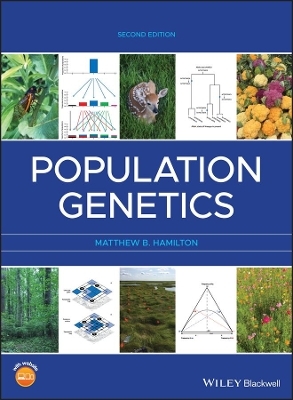
An Introduction to Molecular Anthropology
Wiley-Blackwell (Verlag)
978-1-118-06162-6 (ISBN)
Molecular anthropology uses molecular genetic methods to address questions and issues of anthropological interest. More specifically, molecular anthropology is concerned with genetic evidence concerning human origins, migrations, and population relationships, including related topics such as the role of recent natural selection in human population differentiation, or the impact of particular social systems on patterns of human genetic variation.
Organized into three major sections, An Introduction to Molecular Anthropology first covers the basics of genetics – what genes are, what they do, and how they do it – as well as how genes behave in populations and how evolution influences them. The following section provides an overview of the different kinds of genetic variation in humans, and how this variation is analyzed and used to make evolutionary inferences. The third section concludes with a presentation of the current state of genetic evidence for human origins, the spread of humans around the world, the role of selection and adaptation in human evolution, and the impact of culture on human genetic variation. A final, concluding chapter discusses various aspects of molecular anthropology in the genomics era, including personal ancestry testing and personal genomics.
An Introduction to Molecular Anthropology is an invaluable resource for students studying human evolution, biological anthropology, or molecular anthropology, as well as a reference for anthropologists and anyone else interested in the genetic history of humans.
Mark Stoneking directs the Human Population History group in the Department of Evolutionary Genetics, Max Planck Institute for Evolutionary Anthropology, Leipzig, Germany, and is Honorary Professor of Biological Anthropology at the University of Leipzig.
Preface xi
Chapter 1 Genes: How they are inherited 1
Blood and ABO blood groups 1
Inheritance of ABO blood groups 3
Inheritance of more than one gene: ABO and rhesus blood groups 4
Sex chromosomes 9
Determining how traits are inherited: Pedigree analysis 10
What is—and isn’t—inherited 12
Concluding remarks 14
Chapter 2 What genes are, what they do, and how they do it 15
Chromosomes, proteins, and nucleic acids: Figuring out what genes are 15
The structure of genes and what they do: The central dogma and the flow of information 18
How genes do what they do: Transcription and translation 19
The genetic code 22
DNA replication 23
The consequences of mutations 23
What causes mutations? 25
A final cautionary note 26
Chapter 3 Genes in populations 27
What is a population? 27
The concept of “effective population size” 28
The sex ratio and Ne 29
Inbreeding and Ne 30
Variation in population size over time and Ne 30
Differential fertility and Ne 31
Ne for humans 33
Chapter 4 A simple model: Hardy–Weinberg equilibrium 35
The gene pool with no evolution: The Hardy–Weinberg principle 35
Exceptions 38
A real-life example 39
Some practical uses for Hardy–Weinberg 41
Chapter 5 Evolutionary forces 45
Non–random mating 45
Small population size 48
Mutation 53
Migration 56
Selection 60
Evolutionary forces: Summary 68
Chapter 6 Molecular evolution 69
Functionally less important molecules (or parts of molecules) evolve faster than more important ones 70
Conservative substitutions occur more frequently than disruptive ones 71
The rate of molecular evolution is approximately constant 72
Contrasting phenotypic and molecular evolution 73
How do new gene functions arise? 74
Gene regulation and phenotypic evolution 77
Chapter 7 Genetic markers 79
Classical markers: Immunogenetic markers 79
Classical markers: Biochemical polymorphisms 81
The first DNA markers: Restriction fragment length polymorphisms 84
Polymerase chain reaction 86
DNA sequencing: The sanger method 89
Next-generation sequencing 90
Targeting single DNA bases: SNPs 92
Variation in length 94
Other structural variation 99
Concluding remarks 100
Chapter 8 Sampling populations and individuals 103
Sampling populations: General issues 103
Sampling populations: Ethical issues 105
Archival samples 108
Chapter 9 Sampling DNA regions 111
Mitochondrial DNA 111
Y chromosomal DNA 116
Autosomal DNA 119
X Chromosome DNA 121
Public databases 122
Chapter 10 Analysis of genetic data from populations 125
Genetic diversity within populations 125
Genetic distances between populations 128
Displaying genetic distance data: Trees 135
Displaying genetic data: Multidimensional scaling, principal components, and correspondence analysis 139
Chapter 11 Analysis of genetic data from individuals 147
Genetic distances for DNA sequences 147
Trees for DNA sequences 153
Rooting trees 156
Assessing the confidence of a tree 157
Network analyses 160
Genome-wide data: Unsupervised analyses 161
Chapter 12 Inferences about demographic history 175
Dating events 175
Population size and population size change 187
Migration and admixture 194
Putting it all together 197
Chapter 13 Our closest living relatives 201
Resolving the trichotomy 205
Complications 206
Ape genetics and genomics 208
Chapter 14 The origins of our species 211
Human origins: The fossil record 215
Models for human origins 218
The genetic evidence: mtDNA 222
The genetic evidence: Y chromosome 224
The genetic evidence: Autosomes 225
Chapter 15 Ancient DNA 229
Properties of ancient DNA: Degradation 229
Properties of ancient DNA: Damage 229
Properties of ancient DNA: Contamination 232
History of ancient DNA studies 236
Ancient DNA: Archaic humans 237
Other uses for ancient DNA 244
Chapter 16 Dispersal and migration 247
Out of Africa—how many times, when, and which way did they go? 251
Into remote lands: The colonization of the Americas 259
Into even more remote lands: The colonization of Polynesia 267
Some concluding remarks 281
Chapter 17 Species-wide selection 283
Species-wide selection 284
Nonsynonymous mutations and the dN/dS ratio 284
Tests based on the allele frequency distribution 288
Selection tests based on comparing divergence to polymorphism 293
Archaic genomes 297
Chapter 18 Local selection 299
Example: Lactase persistence 304
Example: EDAR 309
Ancient DNA 318
Concluding remarks 318
Chapter 19 Genes and culture 321
Are humans still evolving? 321
Genetic variation can be directly influenced by cultural practices 322
Genetic variation can be indirectly influenced by cultural practices 322
Using genetic analyses to learn more about cultural practices: Agricultural expansions 326
Using genetic analyses to learn more about cultural practices: Language replacements 332
Using genetic analyses to learn more about cultural practices: Dating the origin of clothing 333
Concluding remarks 339
Chapter 20 Ongoing and future developments in molecular anthropology 341
More—and different kinds of—data: The other “omics” 341
Beyond “you”: The microbiome 344
More analyses 347
Relating phenotypes to genotypes 351
Personal ancestry testing and genomics 360
References 363
Suggestions for additional reading 373
Index 375
| Erscheint lt. Verlag | 27.12.2016 |
|---|---|
| Verlagsort | Hoboken |
| Sprache | englisch |
| Maße | 216 x 279 mm |
| Gewicht | 1111 g |
| Themenwelt | Naturwissenschaften ► Biologie ► Evolution |
| Naturwissenschaften ► Biologie ► Genetik / Molekularbiologie | |
| Naturwissenschaften ► Biologie ► Humanbiologie | |
| Sozialwissenschaften ► Ethnologie | |
| Sozialwissenschaften ► Soziologie | |
| Schlagworte | Anthropologie • Biologische Anthropologie • Evolution • Genetik • Humanbiologie • Mensch • Molekularbiologie |
| ISBN-10 | 1-118-06162-4 / 1118061624 |
| ISBN-13 | 978-1-118-06162-6 / 9781118061626 |
| Zustand | Neuware |
| Informationen gemäß Produktsicherheitsverordnung (GPSR) | |
| Haben Sie eine Frage zum Produkt? |
aus dem Bereich


